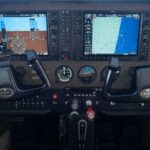A FEW MONTHS AGO, I DECIDED TO BUY A NEW PAIR OF SUNGLASSES. RATHER THAN JUST TRY ON A PAIR AND BUY THEM, I RESEARCHED ALL THE NUMBERS AND ABBREVIATIONS FEATURED ON THE TAGS. THIS TURNED OUT TO BE HIGHLY EDUCATIONAL. HERE ARE MY THOUGHTS AND SOME INFORMATION I LEARNED ALONG THE WAY.
When Glass Cockpits first came out, it was the industry’s buzz. Everyone was talking about the small TV screens installed in cockpits worldwide, and everyone knew where the industry was headed by the time the G1000 came around.
I remember the first time I climbed into one of our new aircraft with a brand new G1000. I looked down and couldn’t see anything on the screen. I turned the brightness control up, but still, nothing. It took me a few minutes to realize that the issue was not the G1000 but me. More specifically, it was my expensive aviator sunglasses with polarized lenses. It turns out that the film on the glass instruments (LCD screens) is also polarized. As many pilots know and understand today, your polarized lenses cancel out the polarized screen on your digital flight instruments, resulting in you not being able to see anything.
This became such a big issue that the FAA conducted a study on sunglasses. While shopping, I discovered that a few high-end sunglasses manufacturers created special nonpolarized sunglasses specifically for pilots. This got me thinking about what else I didn’t know about sunglasses, and it turns out that there is quite a lot that I didn’t know.
As we move into the summer months, many pilots will be flying with clear skies with shiny water below. These environments produce extensive and harmful glare. So what must you do to protect your most important and vulnerable sensory asset: your eyes? If you are young, you may feel invincible. You aren’t. You can begin to damage your eyes today and not feel the repercussions for many years. Start protecting your eyes now.
There are two critical components to protecting your eyes. One is “radiation,” and the other is “glare.” Both pose a hazard to humans and require different methods of protection.
When discussing the sun, two types of radiation affect us. These are infrared and ultraviolet. Exposure to UV radiation increases by 5% for every 1,000 feet of altitude. The warming sensation that you feel from the sun is infrared radiation. UV radiation gives you sunburn, skin cancer, and various eye problems such as macular degeneration. We can protect ourselves from infrared radiation by using sunscreen. To protect ourselves from UV radiation, we need sunglasses.
To protect your eyes, the American Optometric Association recommends you wear sunglasses that protect against 99%-100% of UV radiation. To ensure that you are protecting your eyes from 100% of the UV radiation, make sure that you are wearing sunglasses labeled UV400, the highest rating.
The lens material is next to be considered. Glass lenses can be produced with UV protection embedded in the glass or by coating the lens. They are somewhat heavier, but retain the sunglass tint for a long time. Plastic lenses are lighter and won’t break as easily as glass. They usually have UV protection built in or applied using a coating, and are usually cheaper than glass. Sunglass tinting does appear to fade on plastic lenses over time.
The tint color of your sunglasses is essential as well. Gray, green, and brown are the three most popular tints for pilots. Color is distorted the least using a gray lens. The “screen-out” rating for sunglasses used for flying should be between 70% and 85%. If you have darker sunglasses that block more than 85% of the visible light, you may also start to see visibility degrade.
Now for the critical consideration: do you select polarized or nonpolarized lenses? The FAA does not recommend polarized lenses for use by pilots. This is because many of the cockpit LCD lenses are also polarized. Using polarized lenses will reduce or eliminate the ability to effectively interpret the flight instruments. Ironically, many boaters find the same effect from polarized screens on their instruments. You may even notice such issues with the LCD screen in your car. Another issue with polarized lenses is that they can amplify the effects of a scratched windshield.
Some people choose photochromic lenses, and this is what I was looking for. However, I discovered that the one big issue with these is that their ability to darken significantly reduces in temperatures above 70 degrees Fahrenheit. Many pilots also find these lenses’ “faded” tint too dark to use at night.
Many pilots wear “readers” or bifocal glasses. How to incorporate these into your sunglasses is also an important consideration. Stick-on readers don’t work, as they will fall off.
So, what is a pilot to do? The good news is that I searched for “nonpolarized bifocal sunglasses” and was surprised at the number of options. Many were much cheaper than some of the more expensive ones on the market. So, I purchased a pair of high-end glasses for $160.00 and a pair for $17.00 to see if there was a noticeable difference.
The high-end glasses were heavier and felt much more solid. The cheaper pair were very light and felt like plastic. The high-end glasses had transition lenses that incorporated the bifocals into the lens. The cheaper glasses had the bifocals glued to the inside of the lenses. Looking at the water and then the sky, both appeared to have the same visual qualities. The bifocal difference took a little time to get used to, but both allowed me to read the LCD screens.
Bottom line: do some research and use the criteria above to see which works best for you.










